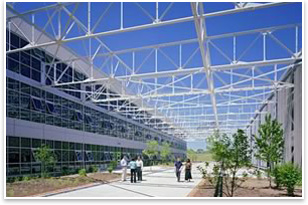
| SUSTAINABILITY The Missing Link: Small Buildings and Sustainability Certification Summary: Have you noticed something a little lopsided in sustainable building certification? The smaller the project, the less likely it will be certified. The 2006 AIA/Committee on the Environment Top Ten Green Projects is a good example of this phenomenon. The 10 projects range in size from just under 2,000 to 380,000 square feet. Of the 10, only 2 are LEED-NC certified: the biggest one and the third largest, at 109,000 square feet. Only one project, a house, is not eligible for LEED certification, although LEED for Homes is now in the works and pilot projects are being tested around the country (more about this development in a future column). S Another reason is that architects, contractors, and product manufacturers who specialize in smaller-sized projects (less than 20,000 square feet) tend to have less experience with sustainable building practices than their professional counterparts involved in bigger, higher-profile projects. Smaller buildings may have specialized programming that falls outside the purview of the standard office buildings for which LEED-NC was originally intended. An example might be a library or a school with lots of multi-use spaces for a small town where every tax dollar counts. Our firm is now in the process of studying how smaller projects can have a better shot at certification for sustainability. One thing we’ve noted is that to succeed in LEED, the project teams for small projects need to capitalize on their assets. The most important aspect is a highly motivated project team willing to do a bit more probing into the certification process, along with a client who is committed to supporting the team’s work to deliver a building that can be certified.
Smaller projects also have alternatives when it comes to design tools that can help the team achieve a sustainable building. For instance, using sophisticated and cumbersome energy modeling software tools on a modest building might be time-consuming, which means that the valuable information from such analysis might not be available until later in schematic design or design development, when it’s too late to make major changes. Smaller and simpler projects can take advantage of alternate strategies for evaluating energy performance, using simpler modeling tools, thereby minimizing a major certification cost while optimizing whole-building performance. Such custom-fit and streamlined strategies can be applied throughout the building process to ensure that projects can be “little” and still certifiably green. |
||
Copyright 2007 The American Institute of Architects. All rights reserved. Home Page |
||
news headlines
practice
business
design
Michael J. Crosbie is a senior associate with Steven Winter Associates Inc., and the chair of the Department of Architecture at the University of Hartford. He can be reached at MCrosbie@swinter.com.
Two out of 10 2006 COTE Projects pursued LEED certification:
Alberici Corporation Headquarters, Overland, Mo., by Mackey Mitchell Architects, achieved a Platinum LEED rating.
The Animal Foundation Dog Adoption Park, Las Vegas, by Tate Snyder Kimsey Architects, is on track for a Platinum LEED rating.

 maller commercial and institutional buildings are the “missing links” in sustainable certification. How come? Their size is one reason. The costs and effort associated with the certification process have traditionally been more effectively distributed over a larger building area. The little guys (small developers, private institutional clients, and town-sized governments) have a number of hurdles to clear in building and certifying a green project, such as the cost of hiring a separate green consultant as part of the team; conducting energy modeling; making sure that building systems are properly commissioned; and ensuring that all of the sustainable materials, systems, and procedures are thoroughly documented for certification.
maller commercial and institutional buildings are the “missing links” in sustainable certification. How come? Their size is one reason. The costs and effort associated with the certification process have traditionally been more effectively distributed over a larger building area. The little guys (small developers, private institutional clients, and town-sized governments) have a number of hurdles to clear in building and certifying a green project, such as the cost of hiring a separate green consultant as part of the team; conducting energy modeling; making sure that building systems are properly commissioned; and ensuring that all of the sustainable materials, systems, and procedures are thoroughly documented for certification. Having a realistic picture of what is expected for certification is key. For a smaller project, even before design actually starts, a sustainability consultant can help the team and the client understand one LEED rating system over another, the levels of documentation that will be needed depending on the certification, and finding an approach that is calibrated to the size of the project and the budget. This upfront work can help the team avoid wasting time and money trying to figure out what certification to go after and what the impact on the project budget might be.
Having a realistic picture of what is expected for certification is key. For a smaller project, even before design actually starts, a sustainability consultant can help the team and the client understand one LEED rating system over another, the levels of documentation that will be needed depending on the certification, and finding an approach that is calibrated to the size of the project and the budget. This upfront work can help the team avoid wasting time and money trying to figure out what certification to go after and what the impact on the project budget might be.